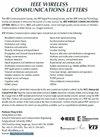混合主-被动共生无线电的最小总传输时间
IF 5.5
3区 计算机科学
Q1 COMPUTER SCIENCE, INFORMATION SYSTEMS
引用次数: 0
摘要
混合有源无源共生无线电可以解决传统共生无线电中辅助用户(SU)传输速率低的问题,但忽略了对时间敏感的物联网至关重要的传输延迟问题,且其传输性能受限于主用户(PU)的低发射功率。本文提出了一种新的传输时间调度结构,该结构由纯能量收集(EH)、反向散射通信(BC)和有源通信(AC)相组成,而不是仅仅包含BC和AC相,并提出了一个非凸问题,以最小化所有su的总传输时间。利用逐次凸逼近(SCA)和辅助变量将原问题转化为一个凸问题,并提出了一种基于逐次凸逼近的迭代求解算法。研究发现,为了使总传输时间最小化,至少有一个SU消耗每个传输块中收集的所有能量,同时将其吞吐量保持在最低要求水平。仿真结果验证了所提出迭代算法的快速收敛性,以及在低PU发射功率下所提出的传输时间调度结构在所有su的总传输时间和PU发射功率可行区域方面优于现有结构。本文章由计算机程序翻译,如有差异,请以英文原文为准。
Minimizing Total Transmission Time in Hybrid Active-Passive Mutualistic Symbiotic Radio
The hybrid active-passive mutualistic symbiotic radio can address the low transmission rate of the secondary user (SU) in the traditional mutualistic symbiotic radio, but the transmission delay, which is very critical for time-sensitive Internet of Things, has been overlooked, and its transmission performance is limited at a low primary user’s (PU’s) transmit power. In this letter, we propose a new transmission time scheduling structure that consists of pure energy harvesting (EH), backscatter communication (BC) and active communication (AC) phases, rather than only containing BC and AC phases in the previous work, and formulate a non-convex problem to minimize the total transmission time of all SUs. Employing successive convex approximation (SCA) and auxiliary variables, the original problem can be transformed into a convex one, then a SCA-based iterative algorithm is proposed to solve it. It is found that for minimizing the total transmission time, at least one SU consumes all harvested energy in each transmission block while maintaining its throughput at a minimum required level. Simulation results validate the swift convergence of the proposed iterative algorithm and the superior performance of our proposed transmission time scheduling structure at a low PU’s transmit power, compared to the existing ones in terms of the total transmission time of all SUs and the feasible region of the PU’s transmit power.
求助全文
通过发布文献求助,成功后即可免费获取论文全文。
去求助
来源期刊

IEEE Wireless Communications Letters
Engineering-Electrical and Electronic Engineering
CiteScore
12.30
自引率
6.30%
发文量
481
期刊介绍:
IEEE Wireless Communications Letters publishes short papers in a rapid publication cycle on advances in the state-of-the-art of wireless communications. Both theoretical contributions (including new techniques, concepts, and analyses) and practical contributions (including system experiments and prototypes, and new applications) are encouraged. This journal focuses on the physical layer and the link layer of wireless communication systems.
 求助内容:
求助内容: 应助结果提醒方式:
应助结果提醒方式:


